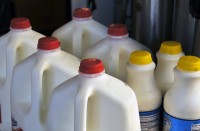THE looming crisis of antibiotic resistance means diseases that were once easily treatable are becoming deadly again. The over-prescription of antibiotics for conditions that don’t require them is spurring resistant mutations leading to so-called superbugs – multi-drug-resistant infections that can evade the medicines designed to kill them.
“What we’ve done as a human species is to basically coat the world in antibiotics by our overuse and inappropriate use. So, we’ve selected for these resistance mechanisms in the bacteria, so it’s why we’re seeing the problem that we’re seeing now,” said microbiologist Dr. Adam Roberts from University College London.
The race is now on to develop new medicines to treat these emerging, mutating infections.
Only a few new antibiotics have been developed and brought to market in the past few decades, but one surprising source of hope has recently emerged — beards.
The discovery came after a separate study to test the theory that most beards contain traces of faeces.
Swab samples were taken from 20 beards, with at least 100 bacteria growths detected.
“There was a previous study that showed there was a lot of faecal bacteria present in some of the beards analysed,” Roberts said. “We wanted to either disprove or prove that that was actually correct, and we could find no evidence of that.”
Microbiologists subsequently ran tests on all of the isolates that were taken from the beards as part of the research into new antibiotics.
“What we do is grid out the individual bacteria on an agar plate which has been pre-inoculated with an indicator strain. And then we see if that indicator strain can grow right up to the individual colonies from the beards or from anywhere else that we’ve got these bacteria from,” explained Roberts.
“And we found, quite surprisingly, that the beard isolates were quite capable of killing the indicator strain that we have; showing that they actually produce antibiotics themselves.”
Of about a hundred bacteria isolates taken from 20 beards, around 25 percent of these showed antibiotic activity against their indicator strain.
Medical science is currently in what’s known as a “discovery void”, with very few new antibiotics developed since the so-called ‘golden age’ of discovery in the 1950s and 60s. A recent British report estimated that antibiotic and microbial resistance could kill an extra 10 million people a year and cost up to $100 trillion USD by 2050 if it is not brought under control.
The team at UCL is part of a global effort to find new antibiotics before this crisis becomes more desperate. He said that while it might seem contradictory to be looking for even more antibiotics when it was their overuse that in-part triggered the current situation; having a raft of new medicines available would allow doctors to limit how long they are used for before they were put aside for a number of years. This would put less pressure on the bacteria to evolve resistance.
Roberts has been asking members of the public to send in swab samples to his laboratory from places where bacteria might be thriving. He said there have been some promising results.
“We’ve got other samples from all over the country; from child’s trampolines, to fridges, to cats. We’ve now got a selection of around 50 different bacteria which can kill multiple indicator strains. These include E.coli – a multi-drug resistant E.coli from a urinary tract infection. These include also Candida albicans [yeast infections] and MRSA [Methicillin-resistant Staphylococcus aureus]. So we’re concentrating our efforts now on finding out exactly what these bacteria are producing, because there’s just a small possibility that it might be a novel antibiotic.” (Reuters)







